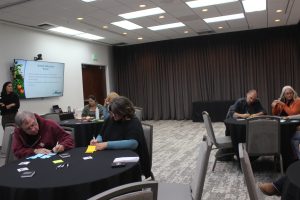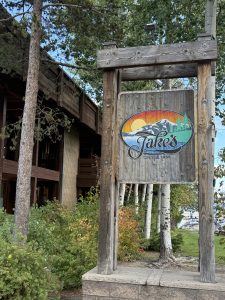Tahoe Truckee Homeless Action Coalition kicks off first meeting
TRUCKEE, Calif. – After 18 months of work developing the action plan, the Tahoe Truckee Homeless Action Coalition (TTHAC) is starting Phase 2, implementing the goals that they set forth in the new plan. During their kickoff, both members of the coalition and the public gave their input on the navigation center—a hot topic with four months to winter.
The TTHAC, which shares its acronym with the previous Tahoe Truckee Homeless Advisory Committee, created the action plan as a roadmap to end homeless within the region within the next five years through the coordination of 12 different regional organizations and the public. It was a project of the Homeless Resource Council of the Sierras and funded through the Tahoe Truckee Community Foundation (TTCF).
During the meeting, Nevada County Supervisor Hardy Bullock, Vice Mayor of Truckee Jan Zabriskie and homeless advocate Cindy Basso spoke about the immediate next steps for the community, focusing on crisis housing stabilization.
The most pressing matter was the navigation center, a site where unhoused people could get support, temporary housing and assistance with transitioning to permanent housing. It would also provide case management and interim beds, serve as an emergency warming shelter, provide meals, provide access to toilets and showers, laundry machines, recuperative care and storage lockers.
Bullock emphasized the importance of storage lockers as a critical need for unhoused people, who often carry all of their belongings with no place to store them during the day, at job interviews or doctor’s appointments. Bullock also told the public that their vision for the navigation center was to provide primarily for local community members, and indicated they had a list of known members in need.
Zabriskie said there was strong support for a year-round facility, but that it was not possible to “have something that ambitious in place for this winter.” He said that the TTHAC was interested in getting an interest check on a pilot version of the program, potentially somewhere along Donner Road, though a solid location had not been chosen.
Basso spoke to the different options that were possible for this upcoming winter, including putting up an emergency warming center. Truckee previously had an emergency center for a little under a decade, but staffing challenges made it difficult to run it, as it was weather-triggered. Additionally, Basso noted that unhoused people were out on the streets again after the weather subsided.
The future navigation center that was envisioned in the plan would need 3,000 square feet to operate, along with $1.5 million per year. Basso did support the idea of the navigation center, especially because “more people are becoming unhoused, not less,” as she stated.
The pilot navigation center would need half the space, but would only aid about four to six people in terms of temporary housing, though it could also operate as a warming center. It would also cost a more manageable $400,000 per year to operate.
Basso noted the urgency from those in the crowd to address this before winter came, but also emphasized that the cost would need to be sustainable (a key part of the TTHAC action plan) and fit well with the community.
The public then dove into questions and a workshop, where a majority of respondents were interested in the pilot program.
Many attendees wondered about what possible locations could be used, suggesting the Joseph Center, the empty church near Drunken Monkey, the veteran’s hall, the parks and recreation building and empty lots near Coldstream Commons.
Several people expected strong support for the pilot program as a proof of concept, and highlighted their desire for timely services, especially for behavioral support and sober living.
Though Jessica Penman, CEO and president of the Truckee Chamber of Commerce, expressed that she was pleased with the turnout, she and others were interested in getting more public buy-in to supporting the TTHAC.
Several people expressed concern with how unhoused people were being viewed or treated, especially with President Trump’s executive order that criminalizes homelessness, linking being unhoused with violent crime. “We have to change the narrative on who is homeless,” said one attendee.
Others said that the existing housing crisis, especially in the Tahoe Truckee region, was something to recognize and contend with. “What housing is there to navigate people to?” asked Rev. Clare Novak, who pointed out that affordable housing options are limited here and that future solutions should be grounded in the reality of the region.
The meeting concluded with a commitment to bring more details and considerations to the public regarding the pilot navigation center sometime in September.
Emily Vitas, senior associate of Agnew::Beck Consulting, was there to facilitate the coalition and the public’s meeting. “This was about the amount of people we were expecting—somewhere between 30 to 50 participants—and there was a good mix of those with experience in housing and those with an interest in getting involved.”
Vitas says they plan to increase public outreach for the next meeting, especially because they are now exploring options for the location of the pilot navigation center.
Seana Doherty, senior manager at Agnew::Beck, said she was pleased with the diversity of voices in the room. “We got participation from people from agencies and partners, to the community, to those with lived experience, to advocates. I think it fostered a better understanding of the difficulties with location and funding, and people came with creative ideas balanced with the constraints we’re dealing with.”
Doherty said that this level of public participation is something she considered vital to a project and hoped to keep people updated through the website they will be launching before August ends.
In the meantime, if you’re interested in getting information or updates on the project, you can email Seana Doherty at seana@agnewbeck.com.
Eli Ramos is a reporter for Tahoe Daily Tribune. They are part of the 2024–26 cohort of California Local News Fellows through UC Berkeley.
Support Local Journalism


Support Local Journalism
Readers around Lake Tahoe, Truckee, and beyond make the Sierra Sun's work possible. Your financial contribution supports our efforts to deliver quality, locally relevant journalism.
Now more than ever, your support is critical to help us keep our community informed about the evolving coronavirus pandemic and the impact it is having locally. Every contribution, however large or small, will make a difference.
Your donation will help us continue to cover COVID-19 and our other vital local news.










